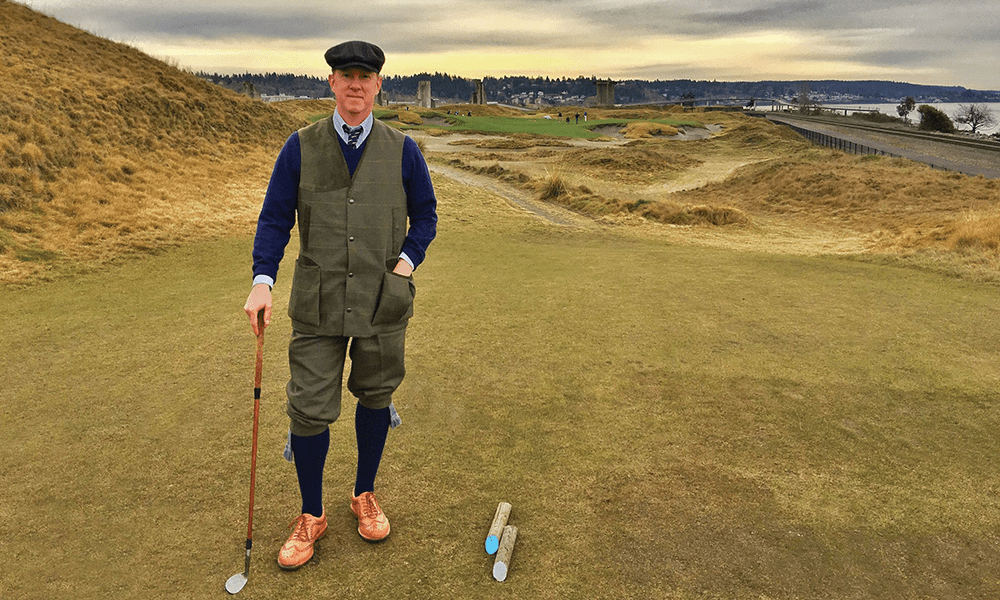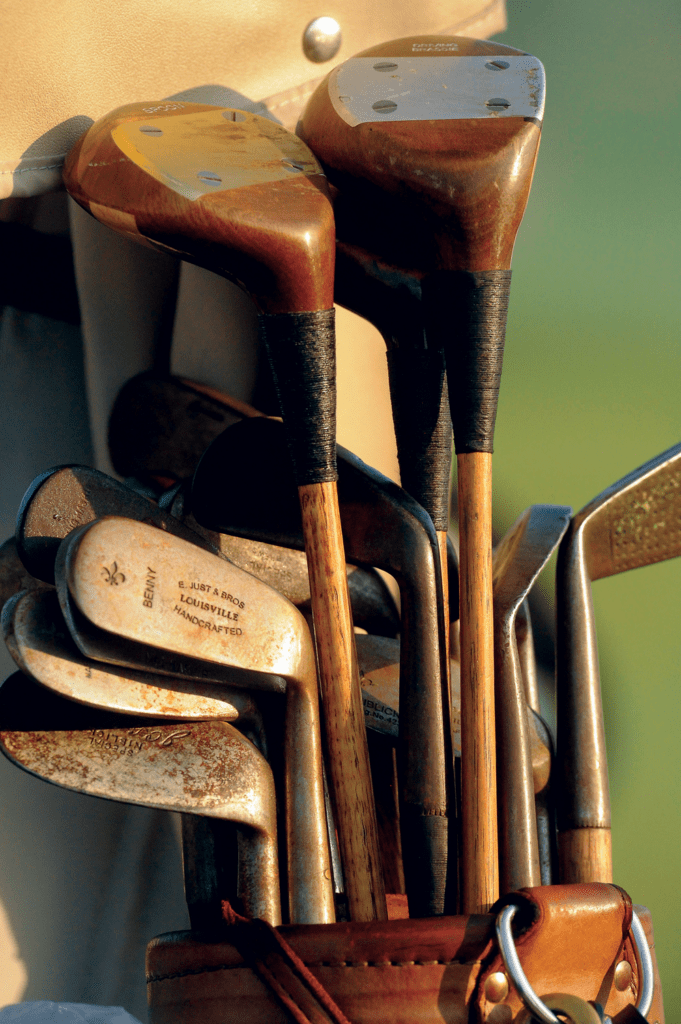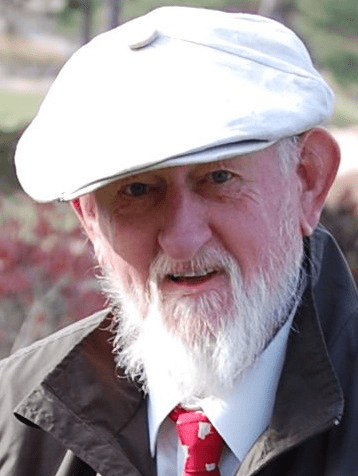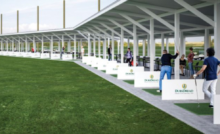The Joys of Hickory Golf: Making the Rounds Part 15


Rob Birman in His Full Tweeds at Chambers Bay


This column features recollections of the author’s 34 years as a golf writer. These installments stem from his many travels and experiences, which led to a gradual understanding that the game has many intriguing components, especially its people.
With millions of people stuck at home during the pandemic, many pursued activities that had fallen by the wayside becoming popular again. The sales of vinyl records outpaced those of CDs in 2020. To some, the manual act of cleaning a record, placing it on the turntable, and putting the tonearm into a groove is more appealing than canned music from a streaming service. Collecting furniture from the 1970s, comic books, jigsaw puzzles, model cars and airplanes, Pez dispensers, Lava lamps, toys, and other oddments also came back into vogue.
Meanwhile, with golf one of the few communal activities available during COVID, some folks took up playing with hickory-shafted clubs. Yet this retro style has been fashionable for years thanks to organizations like the Society of Hickory Golfers, which was established in 2000. It branched off from the Golf Collectors Society (founded in 1970 and now called the Golf Heritage Society). On the other side of the “Pond” is the British Golf Collectors Society, which began in 1987.


The Society of Hickory Golfers (SoHG) focuses on the competitive side while Golf Heritage Society is oriented toward collecting clubs, balls, books, and all things vintage golf. According to Rob Ahlschwede (pronounced “all-swede”), the chairman of the SoHG’s Equipment Committee: “The SoHG was established to set guidelines for hickory competitions that make it easy to offer a fair competition for players using wood-shafted equipment. The Society gives the guidelines and understands that an event will alter them to fit their situation. Anyone is welcome to use the guidelines, members or not.”
While there are dozens of smaller events nationwide, its major annual competitions are played in four regions – the East Coast; east of the Mississippi River; west of the Mississippi to the Rockies; and the Rockies to the West Coast. Each year culminates at the U.S. Hickory Open. The 2021 championship will be held September 14-16 at Gearhart Golf Links, an 18-hole layout on Oregon’s coast whose roots stretch back to the late 1880s.
There are four competitive categories: Open (ages 60 and under); Seniors (60-69); Statesmen (70 and older); and Ladies (all ages). For the U.S. Hickory Open, the course lengths for the respective divisions are Championship – 5,900 to 6,200 yards; Seniors – 5,200-5,500; Statesman – 4,800-5,300; Women – 4,200-4,500.
“We feel that 6,200 is the max unless the course plays shorter because it’s hard, firm, and dry,” says Ahlschwede. “There is some distance gap between the Championship length and Seniors. That can sometimes be altered as the situation suggests. These are guidelines – not ‘hard’ rules – and we appreciate allowing for alterations.”
So why is hickory golf so alluring? Its adherents share a sublime and deep appreciation for the sport. “I love golf but had no idea what I was missing,” said Pat Flynn, a 4-handicap and former club champion at Sand Point in Seattle who took it up in the past year. “Playing hickories makes you see the course and game in a different light. The sound of the ball coming off a well-hit driver, a well-struck mashie, a bump-and-run from 40 yards are all better than any shot I have hit with my modern clubs. What is just as fun are the bad shots. The sweet spot on the clubs is not big, and the feedback up your arms and in the air is immediate. The swing tempo needed (for hickories) is making me a better golfer. I am not sure how much longer I am going to play with modern clubs.”
John Henry Williams, who has competed in regional and national hickory events for decades, retired as an assistant golf course superintendent at Sand Point. “We all love golf, but something about the appeal of playing clubs from a bygone era appeals to me,” the Virginia native said. “The feedback is instantaneous, as is the complete sense of satisfaction when you hit a solid shot. That whooshing sound the club makes as the hickory shaft glides through the air before impact on the clubface is very cool. And it does make me a better overall golfer.”
On a personal note, Williams added: “Playing hickory turns almost every golf course into a championship test. Courses don’t have to be 8,000 yards to be great. It’s not about who can hit it the farthest with hickories but who is the most creative. Golf in the U.S. is about hitting it in the air and dropping a shot on a target. Hickory golf is more about how do I maneuver my way around the course? (The clubs don’t provide) enough backspin on the ball to stop it on a dime.
“No doubt, manicured courses are wonderful and delightful to play. But if there isn’t the budget or capability to create such conditions, hickory golf is a hoot on all types and conditions of courses.”
Hickory clubs have much more variety than modern clubs. Indeed, many of the older contraptions would be outlawed today. Williams has one club with “such a flat pitch that it can go underneath a ball and it will never move.” There are “rut irons” for hitting out of wagon ruts (“Play the ball where it lies!” mandated the ancient Scots) with very narrow heads (less than 2 inches across); giant niblicks (with club faces 9 inches wide). Some were designed to hit out of the water and have holes on the face; “deep-grooved” clubs have wide and deep “scoring” for extra spin. “You can rip the cover off the ball with a deep groove,” Williams noted with amazement.
For a primer, here is a conversion of clubs, with hickories listed first and their modern equivalents next. (Author’s Note: Wearing plus-fours is optional when playing wood-shafted clubs.)
| Play club | driver |
| Brassie | Named after the baseplate made of brass; equivalent to a 3-wood |
| Spoon | Higher-lofted wood; like a 5-wood |
| Baffing spoon or Baffy | Approach wood; like a 7-wood |
| Driving iron | 1-iron |
| Mid-iron | 2-iron |
| Mid-mashie | 3-iron |
| Mashie iron | 4-iron |
| Mashie | 5-iron |
| Spade mashie | 6-iron |
| Mashie-niblick | 7-iron |
| Pitching niblick | 8-iron |
| Niblick | 9-iron |
| Jigger | Though a very low-lofted iron with a shortened shaft, this is used like a modern chipper |
| Cleek | A club with an elongated blade but little loft, equivalent to a 1- or 2-iron |
| Lofter | A club with a moderate loft ranging from a modern 5-iron to an 8-iron |
| Rut Niblick | a trouble club and pitching iron. Generally, the most lofted of the 19th-century irons with a small, rounded head and a loft equivalent to a modern 9-iron or wedge. |
The transition from hickory to steel shafts occurred in 1930, the year Spalding introduced its Bobby Jones Signature set of irons. The clubs featured steel shafts painted tan to simulate the look of hickory. The move from gutta-percha golf balls to more modern spheres came with the advent of the Haskell ball (named after Coburn Haskell, an employee of the B.F. Goodrich Company) in the late 1800s. Haskell secured a patent for the wound, covered balls, and died a very wealthy man in 1922. Many subsequent upgrades have resulted in today’s high-tech golf balls.
“Hickory players can use modern-day softer golf balls,” said Williams, a gifted woodworker who crafts new hickory inserts (faceplates) for clubs. “McIntyre Golf makes golf balls with square patterns, kind of like the Cayman ball, with the dimples convex versus concave.” Some hickory players use the old gutta-percha balls (originated in 1848 by Dr. Robert Adams Paterson), but many of these have been scooped up by collectors. Created from the dried sap of the Malaysian sapodilla tree, the “gutties” can lose their shape. But Williams says of what he calls an “environmentally-friendly golf ball”: “It’s natural rubber. You can put a ‘gutty’ in hot water and remold it to its original shape.”
Alschweide admits that the cost to get into hickory golf and compete at the highest level can be steep. “It will set you back some. But if you just want to play for fun, much less cash is necessary.”
One of the “first decisions to make is the purchase of original/antique clubs or modern authenticated replica clubs,” Alschweide advises. “Replicas will get you going right now with high-quality shafts and good heads – $1,500 to as much as you want to pay. For antique originals, it costs less but takes time to find good shafts and heads. Niblicks of quality are a challenge – you can pay anywhere from $50 for a common, not-too-bad club that might even have some bounce! – to over $3,000 for a pristine original. Yet all great originals have been carefully replicated and cost what a quality modern wedge might.
“The rarest clubs to find are quality niblicks and drivers. Putters, too, but they are, as we know, very personal, and sometimes a $5 common blade is fine,” he added. “I paid $600 for an original center-shafted mallet a few months ago. It is one of only three I know of and is a fantastic face-balanced 1910 putter.
“What we usually tell newbies is that they can get replicas now and later find originals to match their games. Most players who start with replicas eventually gravitate to originals, usually because of a growing interest in the older clubs. And, just like modern golf, it’s all about the shaft. Getting shafts to match is a painstaking task. Clubmakers can do that for you, but it comes at a cost. A member won one of our big tournaments with an all-replica set. The next year he defended with an all-original set and won again! Many players now use a ‘hybrid’ set – a mix of replicas and originals/antiques –which make up about 70 percent of the field at a U.S. Hickory Open.”
As noted earlier, the big difference between hickory and contemporary clubs is distance. Modern-day hackers have benefited from technology, but that has rendered many shorter courses obsolete or downright dangerous to other golfers and neighboring homes. “I have found there is about a club to a club-and-a-half difference in distance,” said Williams. “The (wood) shaft both flexes and has torque. Better timing and rhythm in the swing result in better shots. Successfully playing with hickories requires a more graceful swing than the relative violence of modern golf.
“Some players will never enjoy hickory golf. But those who let the game touch their soul find it enormously rewarding and addicting. Hickory golf levels the playing field among a wider segment of golfers. The strongest hitters don’t dominate nearly as much,” added Williams with a tinge of introspection. “You can hit drives a long way once you get the timing down with hickories, but that feel you get with a good shot is much more enjoyable. Handicaps are higher with hickory, no doubt, but the lowering of your hickory handicap is more satisfying. Make a bad swing with hickories and you will not hit a good shot, unlike modern clubs.
“Today’s club manufacturers advertise their clubs as more forgiving and the ‘straightest clubs ever.’ They are trying to make the game as easy as possible. There is a place for that in the golfing world. But if you want to challenge both yourself and your game, try hickory golf.”
“I truly believe playing hickory clubs makes you a better golfer because it takes a fine swing to hit a fine shot and there is something pure and innocent about that,” enthused Craig Hunter, Sand Point’s director of golf. “It captures your imagination and allows you to be creative on the type of shot you want to play. Bounce it up, use the ground to your advantage,” said the Scotsman from the Isle of Skye. “Think of Seve (Ballesteros) when he burst onto the scene during the 1976 Open Championship at Royal Birkdale. On the final green, playing with Johnny Miller, he chased a bump-and-run in between two pot bunkers and rolled it stiff to a tucked pin. I’ll never forget Peter Alliss calling it ‘a cheeky shot.’
“My first time trying them was with Mr. Flynn. I made two birdies on the front nine and was completely hooked. Hickory golf has revived my love of golf and captures the true spirit of the game.”
“What I find so alluring is the club selection and myriad choices hickory golf involves. The modern ‘air’ game can get a little one-dimensional. Learning to hit punch shots, run-up shots, and to play a ground game brings so much joy to me – so much so that I’ve played only hickories for over 10 years,” said Robert Birman, who co-founded the Northwest Hickory Players with club-builder Jim von Lossow and historian Martin Pool in 2015 and hosts the “Plus Four Podcast” on hickory golf. “The sound is different, my expectations are different, and I feel a connection to the pioneers of an old game so often overlooked by modern golfers.
“It’s a connection to the way courses were once set up and forces you to think creatively, not just in a cookie-cutter mentality. I hope readers will try it, even if only once. It can transport you to a past time and place and bring a much deeper appreciation for the game of golf.”
The 69-year-old von Lossow, a lifetime member of the PGA of America, worked at various courses throughout the western U.S. From 1990-2017, he owned Von’s Golf in Seattle, becoming a renowned club-fitter and master clubmaker. He first used hickory with Pool during a round at Seattle’s Jackson Park Golf Course in 2013. “I shot a 76 and was hooked. When I tried hickories, it brought back my love of the sport. It offers shot-making, strategy and a wonderful collection of like-minded golfers.”
Now a resident of Spokane, von Lossow appreciates the upbeat attitude of hickory players. “They are people from all walks of life who are friendly and happy to be playing the game. There are no sourpusses in hickory, something I had never experienced in golf before.”
With his background, it’s not surprising that von Lossow has been successful in events (he carries a 3 handicap with modern clubs and 7 with hickories). His son, Andrew, shoots even lower. The 33-year-old is a plus-4 with moderns and plays scratch with wood-shafted clubs.
“I have won numerous gold medals [traditional golf trophies aren’t awarded to hickory tournament winners] in Scotland, Pinehurst, Wisconsin, Arizona, Oregon and Washington,” said Jim, who now plays hickories 80 percent of the time. He has also taken a deep dive into building hickories for other folks. “I stock over 300 hickory irons and 50 to 75 woods. They are refinished, given new shafts if needed, reglued, whipped and pinned. Woods have new finishes and I bring the engravings back to life. I purchase calfskin hides, then cut my own grips to replace the original slick ones.”
The enjoyment of playing with vintage golf equipment extends to female SoHG members like Marci Likens. “There is a purity to a shot well struck with a hickory club,” said the resident of Winter Springs, Florida. “What you swing is what you get, while modern clubs are designed to correct for less-than-perfect swings. The sound of the swing and ball contact with hickories is unmatched.”
Likens finds the organization very accepting of women players, though she would like more representation. “I would love to see more women try it. Right now, our numbers are small in many events. But I always feel welcome at tournaments and enjoy the camaraderie of fellow hickory golfers. Our Florida State Golf Association (www.fsga.org) has begun a hickory initiative that includes 11 one-day events and a two-day Hickory Open in 2021. We have seen a number of men and women play with hickory clubs for their first time at these and they’ve expressed an interest in continuing.”
There are several golf course superintendents who are hickory buffs. Among them is Matthew Wharton, CGCS, MG, at Carolina Golf Club, a 1929 Donald Ross design in Charlotte. He started playing in 2016 and is a member of SoHG. Wharton agrees that manicured course conditions are unnecessary when playing with wood-shafted clubs.
Indeed, the more old-school the venue the more enjoyable. “I believe the classic courses are best suited for hickory golf where the ground game comes into play,” he said. “If you are a golf course superintendent on a modern course with numerous water features, bunkers guarding the fronts of greens, and other forced carries, I think you will find hickory golf extremely difficult and frustrating.
“I once played Lynch Links on the campus of Emory and Henry University in southwest Virginia. It was a potpourri of grasses on the fairways and the greens were thatch, with some moss present, but the experience was fun beyond belief,” Wharton added. “I enjoy playing Carolina Golf Club with my hickory clubs, especially when the course gets dry and bouncy in the fairways.”
Like every hickory adherent I talked to for this article, Wharton finds something magical about it. “I do believe playing with wood-shafted clubs helps connect us to the past. I am a history lover from a young age. Golf has a rich history, so hickory golf falls perfectly into place for me.”
Other golf course superintendents into hickory golf include Craig Spicer of Legends Golf & Country Club in Calgary, Alberta (site of the annual Canadian Open Hickory Championship); Robert Arrington at Catawba Country Club in Newton, N.C., who travels to play the historic Oakhurst Links in West Virginia, a past host of the U.S. Hickory Open; Steven Neuliep of Etowah Valley in North Carolina; Joel Kachmarek at Tacoma Country & Golf Club; Ben Ellis at Ft. Belvoir Golf Club in Virginia; and Ryan Pitkonen at Fairways at West Terrace in Cheney, Washington. Another noted golf course industry proponent is Rob Pilewski, a PGA of America instructor at Duke University involved in the Carolina Hickory Golf Association.
Kachmarek believes hickory golf might influence how golf course superintendents think about conditioning their courses. “Playing wood-shafted clubs has only reinforced my existing outlook, and that is dismal since we have lost ‘golf’ almost entirely. The hunger for continued equipment modifications makes me sad. I love grabbing my hickories and playing with my daughter from the most forward set of tees. I don’t care how far I hit it as long as I safely navigate the hazards in front of me.
“I think many golf course superintendents, including myself, get caught up in making the place green. All golf, modern or hickory (eras), is improved when the course is less green,” added Kachmarek, who tends Tacoma C&GC, which was founded in 1894.
When asked whether golf course superintendents would benefit by getting involved, Ellis replied in the affirmative. “Other golf course superintendents tend to find hickories neat,” he said. “But they don’t want to commit to playing until I hand them a club, tell them to take a solid swing at the ball and that they are not going to break it.”
As noted earlier, this style of retro golf is ideal for shorter, less-manicured courses. “Oftentimes, a better golfer wants a top-notch golf course with lightning-fast greens and 7,000 yards,” Ellis said. “With hickories, that same player can enjoy a shorter golf course with a little taller rough and slower greens because those were the conditions being played when hickories led the game. Playing with hickories, I enjoy an executive-length or par-3 course more than a newly built championship layout. I only carry about seven clubs, and I usually play better. You learn how to play different shots and there is a lot less to overthink. Hickory golf is an entirely different game than playing with the latest and greatest equipment.”
Ellis considers the SoHG’s website (https://www.hickorygolfers.com/) a wonderful resource for all things hickory golf. He noted it as “a fantastic way to start getting involved and finding more information.” Included are local playing groups, ideas for acquiring and restoring wood-shafted clubs, replica-club manufacturers, compiling a set of clubs, and much more useful information. Annual Society memberships are $35.
Jeff Shelley has written and published nine books as well as numerous articles for print and online media over his lengthy career. Among his titles are three editions of the book, “Golf Courses of the Pacific Northwest.” The Seattle resident was the editorial director of Cybergolf.com from 2000-15. For seven years he served as the board president of First Green, an educational outreach program that is now part of the Golf Course Superintendents of America and Environmental Institute for Golf.
Read other in Jeff’s Series of Making the Rounds – https://www.golfcoursetrades.com/author/jshelley/
Recent Posts
Memphis Country Club: A Golfer’s Study in Precision and Tradition
If you have ever teed it up at Memphis Country Club, you know this isn’t…
Foley Company attains GCSAA Silver Partner Status
Foley Company, a leader in turf equipment innovation and technology, affirms its support of the…
Harrell’s continues longstanding support of the GCSAA Foundation
Harrell’s LLC, a leading distributor of customized agronomic products for turfgrass since 1941, has donated…
City of Orlando Announces New State-of-the-Art Driving Range at Dubsdread Golf Course
The City of Orlando is excited to announce the construction of a brand-new, state-of-the-art driving…
Discover Puerto Rico for Great Golf Trips and After-Round Activities, Amenities
Golfers cannot live by the game alone which is why Puerto Rico provides the perfect…
Q&A with a Multi-talented Golf Course Architect – Part 2: Making the Rounds – Installment 39
This column features recollections of the author’s 37 years as a golf writer. These installments…

